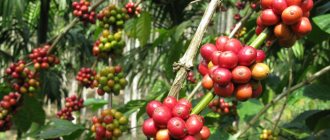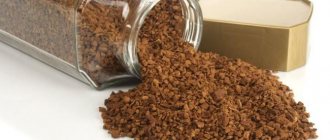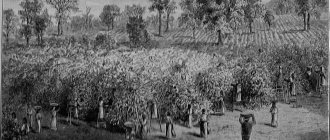It is believed that coffee is the second famous drink after tea. It has many fans who appreciate the drink for its unsurpassed aroma, excellent taste and invigorating effect. In the modern world, coffee is drunk everywhere and always: served at business meetings, corporate events, and celebrations. You can also meet many people in a restaurant drinking a cup of this aromatic drink.
Which country is the birthplace of coffee?
Africa was the first to give the world coffee beans. It is Ethiopia that is still famous for its unsurpassed Arabica coffee. The country produces about two hundred thousand tons of products per year.
Suitable climatic conditions favor the growth of coffee bushes, so Ethiopia grows selected quality beans. It is known that the name of the drink comes from the region where Kaffa grows. But in this province coffee was called “buno”.
In the homeland of coffee, Ethiopia, only Arabica is produced, which is famous for varieties such as Jimma and Harar. They are also added to blends with Colombian beans to provide superior flavor and aroma.
Arabica is produced using the dry method. The fruits are dried for two weeks in the sun, then the grain is removed from the shell.
From Africa, the invigorating drink came to Yemen, and then began to spread throughout the world.
Some argue that the birthplace of coffee is Brazil. But this is not so, grains were brought there by pilgrims in the eighteenth century. And then the Brazilians began to grow coffee bushes on their own. Therefore, the country is considered the second homeland of the invigorating drink.
Distribution in Europe
Coffee began to be consumed in Europe in the seventeenth century. The first time anyone could enjoy this exquisite drink was in 1626 in Rome. According to another version, this product appeared on the territory of European countries thanks to a botanist from Germany, Bellus.
The very first coffee shops were opened in the following cities:
- London (1652);
- Marseille (1671);
- Paris (1672).
Until the beginning of the eighteenth century, coffee was elevated to the title of the national drink of the Kingdom of Great Britain. By the beginning of 1702, there were already two thousand coffee houses in London. Women were prohibited from entering them. It was only in 1717 that the first shop was opened where the fair sex could enjoy a cup of tea. Coffee continued to be unavailable to them. This resulted in a gradual displacement of coffee. Tea took the lead.
It is worth noting that the word “coffee” was not used previously in Europe. In ancient times, this aromatic drink was called “Arab wine.”
How coffee appeared: legends
The properties of the coffee bush were first discovered by a shepherd named Kadim. It was he who noticed that after the goats ate the leaves and fruits of the tree, they became more active and hardy. In the eight hundred and fiftieth year of our era, people began to brew an infusion of leaves and berry peels; such a drink gave vigor and energy.
Then we learned how to dry and fry the fruit peels. The raw materials were crushed and an invigorating aromatic infusion was brewed. Over time, people began to prepare coffee using the classic method from dry roasted beans.
According to the second legend, the first person to discover the properties and effects of coffee beans was a sheikh from Yemen. In addition to his studies in pharmaceuticals and government, he wrote scientific works. In them, he argued that after drinking an infusion of grains, an invigorating effect occurs, the mind becomes clear, the body is filled with strength. Coffee products began to be imported to Europe at the end of the sixteenth century.
Collection and production
During one harvest, up to two hundred fruits are removed from a tree. This is done manually. Ripe fruits that are available are cut with a knife. The rest have to be knocked down with a long stick. The processing method has also not changed much since the time of the conquistadors.
To extract the seeds, the cocoa fruit is crushed and opened by hand. Then the raw beans are spread on a layer of banana leaves and covered in the same way. The seeds remain in this position for about a week. Fermentation occurs, due to which cocoa acquires its original smell and taste.
The next stage is drying. The seeds are dried in the open sun for a week to 10 days. To ensure even drying, the beans are turned over every day. On modern farms, special ovens do this work. Losing moisture, the seeds become almost twice as light. Now cocoa beans look much more appetizing. The raw materials are placed in bags and are ready for processing.
At the factory, the grains are roasted and ground. Part of the product is used to extract the oil from which chocolate is made. The remaining mass (cake) is thoroughly crushed in a crushing machine. The best cocoa powder is the one that has undergone alkaline processing.
Don't miss: Which cocoa powder is best to buy?
The crushed beans are placed in a mixer along with an alkaline-water solution. The heat treatment then helps the lye vapors kill any harmful microbes. High-tech equipment for complex processing has been developed in Germany. One machine does drying, roasting, grinding and alkaline processing.
Coffee countries
We already know that Africa is considered the birthplace of coffee. Since there are many varieties, they are not all from Ethiopia.
Liberia is a coffee variety that was originally grown in the African country of the same name Liberia. Over time, grains of this variety began to be produced in other countries.
Yemen is considered the birthplace of such a variety as mocha. They call it that because its origin is from the city of Moha. This area is dominated by soils with a special composition, and the grains grown on these lands are moderately acidic. And the soils in American and African countries have high acidity, and the taste of the brewed drink from these grains is sour.
The Heart of Ethiopian Hospitality
“Serve them coffee in bamboo cups,” said Annaz Haile, the head homemaker, popularly known as the matriarch, as my companion Thomas and I joined the rest of the guests at her coffee ceremony outside her home in rays of the morning sun. We were in the village of Bonga, in the southern mountains of Ethiopia, in the province of Kafa.
The guests chatted in the local dialect "Kafi Noonoo" while Annaz and her daughter Asayech prepared coffee for them. Her husband, Gebremariam, tore the homemade bread into several huge pieces and instructed the children to distribute it to the guests.
Brazil is the second home of coffee
Although Africa is considered the birthplace of coffee, Brazil occupies a leading position in the production of beans. The country produces forty percent of the world's coffee production. Despite the large volumes, the quality of the coffee is also monitored here. A drink from Brazil will satisfy any consumer. It is there that grains with different taste and aromatic properties grow; almond, floral, chocolate.
Brazilians call the drink caffecino, in our opinion it is espresso. Local residents drink it at any time of the day and in unlimited quantities, twenty small cups each. In Brazil, coffee is prepared according to different recipes; it can be brewed with milk, honey, citrus fruits, cream and other ingredients.
Modern history
The history of coffee is still being written today. In recent decades, an unprecedented variety of drinks for every taste have been prepared from coffee beans. According to rough estimates, their number is three dozen. Cappuccino, mochaccino, latte, Americano, lungo, Irish, Fredo, caretto and dozens of other recipes.
Methods of preparing coffee have also expanded. Today it is brewed not only in a Turk, but also prepared in espresso machines from whole beans or using special capsules. There are real professionals in preparing a variety of coffee dishes - baristas.
The assurances of skeptics about the dangers of caffeine do not stop lovers, especially since it is simply impossible to deny the therapeutic effect of this substance. The number of admirers of the aromatic drink is becoming so large that there is concern that it will be impossible to provide everyone with a natural product.
Interesting facts about coffee:
- Sales of coffee beans are second only to oil in volume.
- If you only inhale the aroma over a freshly brewed cup, you can already get a portion of antioxidants equal to three oranges.
- Every year, 500 billion servings of coffee are consumed on the planet.
- Arabica is the most common variety; almost 70% of coffee lovers drink it, and only 30% prefer Robusta.
- The prepared drink has 800 aromatic and 1200 chemical compounds.
- Luwak is the most expensive type of coffee bean. The price per kilogram reaches $1,200. The grains are distinguished by an unusual “processing”; they are obtained from the excrement of musangs. After passing through the animal’s digestive tract, they acquire special taste qualities.
Coffee helps you wake up, concentrate, and fill your body with energy. He struggles with excess weight and depression. This product has become a symbol of a cheerful morning and a romantic evening.
Brazilian coffee recipe
Residents brew a delicious sweet drink that everyone will enjoy. To prepare it you will need the following ingredients:
- A teaspoon of ground coffee beans;
- Fifty grams of dark chocolate;
- Two cups of hot milk;
- Whipped cream;
- Sugar.
First, brew the coffee and strain it, add the chocolate pieces. Pour this mixture into a large container, pour in hot milk and beat well with a mixer. Now add sugar to taste, pour into cups and garnish with whipped cream.
Varieties of coffee
Not everyone knows that there are actually about eighty types of coffee bushes. But mainly two types are produced and consumed: Arabica and Robusta. Types such as Excelsa and Liberica are not used to prepare the drink; they are used in cosmetology and the confectionery industry.
Arabica
This variety of coffee tree is highly valued. Arabica is very famous; its bushes grow mainly on mountain slopes and require special care. Trees grow intensively and bear fruit at a certain temperature, when hot days give way to cool nights.
Arabica is often susceptible to diseases, so the grain harvest is not large every time. One bush of this species annually produces up to five kilograms of grains. Due to careful care and growing conditions, Arabica is more valued and more expensive than other varieties.
What is better coffee or cocoa
Cocoa is also considered an invigorating drink and is very popular among many. South America is considered the birthplace of cocoa. It contains an element such as phenylethylamine, which produces the joy hormone endorphin. The drink is also rich in zinc, iron and folic acid. Melanin, which is also part of cocoa, has a beneficial effect on skin condition. Caffeine is contained in the drink, but in an amount that does not harm the body.
Although cocoa is high in calories, you will not gain excess weight, because after the first cup you drink, you will feel full.
Coffee and cocoa have many differences, but they are both delicious, and it is impossible to say for sure which one brings more benefits. When choosing a drink, it should be taken into account that people with cardiovascular diseases are better off drinking cocoa, while coffee can be drunk by those who want to lose weight and do not have health problems.
Vietnam
Vietnam has quickly become one of the largest coffee producing countries, second only to Brazil. In the 1980s, the Communist Party relied on its production, and every year since the 1990s, collections have increased by 20-30%, boosting the country's economy. Large-scale production in Vietnam began in 1995, when trade relations with the United States normalized. Vietnam has found a niche in the international market by focusing primarily on the less expensive Robusta variety. Robusta beans contain twice as much caffeine as Arabica beans, which gives coffee a bitter taste. In 2014, Vietnam produced 1.65 million tons of coffee, almost all of it Robusta.
How did coffee shops appear?
Previously, only wealthy and wealthy people could afford to drink coffee. The Turks began to distribute this drink en masse, and Türkiye is considered the birthplace of coffee shops.
The first coffee shop was opened in Constantinople. This happened in the middle of the sixteenth century. At that time, local stores already sold fresh grains, so there was no time needed for delivery of products.
People came to coffee shops not only to try coffee, but also to talk about business relationships. They became a place for meetings and negotiations, and therefore gained great popularity among the population.
Turkish coffee shops are a good example; such establishments have found popularity in Europe and the Middle East.











